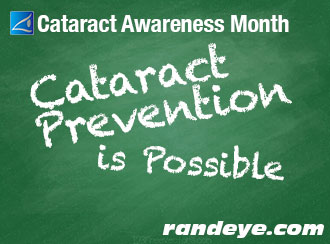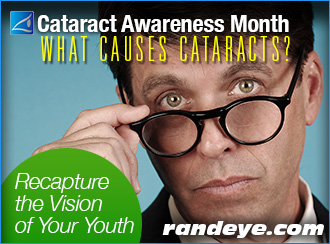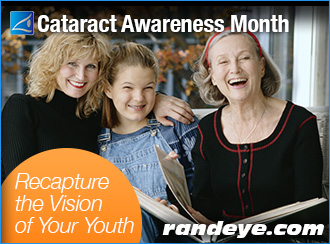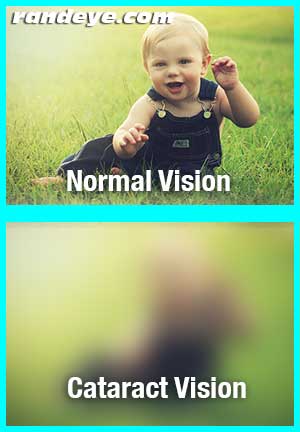What are the signs of cataracts?
Cataracts are one of the leading causes of vision loss in the United States yet can be corrected to restore a person’s eyesight with accurate and precise technology.

What are the signs of cataracts?
A cataract is a clouding of the eye’s natural lens that affects many of us as we age.
- People with cataracts often have blurry or double vision.
- Colors start to appear dull or muted.
- Sunlight seems overly bright or glaring.
- Driving at night becomes difficult due to glare or halos. around traffic lights and signs.
- Your eyeglass prescription changes too often and still is not perfect.
The sooner you address your eye concerns and how they affect your everyday activities, the sooner you can enjoy your new restored vision. A cataract left untreated may lead to blindness.
Cataract Characteristics
Adult cataracts develop slowly over time, beginning at around age 55. The American Academy of Ophthalmology reports that by age 75, about 70% of people will have cataracts.
Experience and Expertise to See Your Very Best
Early diagnosis is important for maintaining good eye health. Fortunately, we live in a time when correcting cataracts is easily accessible, and the results you can get from The Rand Eye Institute can be extraordinary. Ask about Rand Eye’s Custom Laser Cataract Surgery with the LenSx® Procedure and the various options available to provide your best corrected vision. Schedule a comprehensive eye exam today.
Greatest Benefit You Get From Your Vision
It’s Senior Independence Month, and how well you see can make a world of difference in your level of independence.
What is the Greatest Benefit You Get From Your Vision?
Is it socializing with friends? Playing cards or doing needlepoint? Driving, or perhaps driving at night? How about seeing your grandkids? That might be everyone’s favorite.

All of these are fantastic reasons for wanting crystal clear vision, because the quality of your vision is directly related to your enjoyment of life and being more independent. Rand Eye Institute offers many vision options to bring back the independence as experienced back in the days of your youth.
Take a Fresh Look at Cataract Surgery
Cataracts are the leading cause of vision loss in adults 55 and over. A cataract is a clouding of the natural lens inside the eye. After the clouding of the eye, normal activities such as reading, gardening, golf or driving can become difficult.
But there’s good news! Rand Eye Institute offers modern cataract surgery, a simple, painless outpatient procedure to regain your vision, if no other diseases are found in the eye, other than the cataract, there’s a better than 98% probability that your vision will be comparable to what you enjoyed at childhood.
Cataract surgery at Rand Eye Institute is easy and virtually pain-free, and usually takes only 20 to 30 minutes or less, returning you to your normal activities the very next day, you know, those activities like golf, driving and seeing your grandkids!
So, see yourself clear to call us at 954-782-1700 and schedule a comprehensive eye exam. At Rand Eye Institute, we’ll do our best to get you back to doing what you do best.
Cataract Prevention is Possible
There are several ways to prolong cataract development, and one sensible way, is through nutrition. Certain nutrients and nutritional supplements may help you reduce your risk of developing cataracts, so take note of them and put them on a list for your next trip to the grocery store.

While shopping, don’t pass up some old favorites: Whole grain cereal, sunflower seeds, almonds, spinach and avocados, all good sources of vitamin E. Studies have shown that the risk of developing cataracts could be as much as 60% lower when you include these foods in a balanced diet. Don’t overlook kale and other green, leafy vegetables either. While some may not enjoy their taste, remember you can blend them into a tasty and healthy smoothie.
Antioxidant vitamins such as vitamin C and foods containing omega-3 fatty acids may also reduce your risk of developing cataracts, so look to add fish to your plate at least twice a week.
Lastly, an essential and easy step to reduce your risk of cataracts, and to add to overall eye protection, is to wear sunglasses that block 100 percent of the sun’s UV rays.
Cataract Surgery: Clarity in the Blink of an Eye
When symptoms of a cataract appear, you may be able to improve your vision temporarily by wearing new glasses, strong bifocals, magnification, appropriate lighting or other visual aids.
The best way to permanently treat a cataract is Rand Eye Institute’s laser cataract surgery procedure that removes the old, clouded lens and replaces it with a new, custom artificial one, restoring your vision and significantly improving your quality of life.
See Us and See the Best
While experiencing changes in your vision due to cataracts, consider Rand Eye Institute’s advanced cataract surgery technique as a viable solution. Its effective and relatively painless procedure will help you regain crystal-clear vision. Cataract surgery is the most frequently performed surgery in the U.S., with more than 3 million Americans undergoing this vision-restoring procedure each year. Ninety percent of those who have cataract surgery regain clear vision, in the range of 20/20 – 20/40. Call us at 954-782-1700 and schedule a comprehensive eye exam to get back to crystal-clear cataract-free vision.
What Causes Cataracts?
The natural aging process is the main cause of cataracts and the leading cause of vision loss in adults 55 and over.
Our eyes work like a camera, so when we look at an object, light rays reflect off of that object and enter the eye through the cornea. The lens behind the cornea focuses the rays onto the retina, which, in turn, converts the rays into electrical impulses that travel through the optic nerve to the brain. The brain then perceives the electrical impulses as an image.
Seeing depends upon this chain of events, but seeing clear, focused images depends largely upon having a crystal clear lens. Unfortunately, cataracts interfere with that clarity.
Here’s what happens:
- The lens is comprised mainly of water and protein. The protein is arranged in a way that is designed to keep the lens clear and allow light to pass.
- As we age, portions of the protein can clump together and cloud a small area of the lens. Known as a cataract, over time it may grow larger and cloud an even greater area of the lens, making it more difficult to see clearly.
Types of Cataracts:
- Sub capsular cataracts occur at the back of the lens. People with diabetes or those taking high doses of steroid medications have a greater risk of developing a sub capsular cataract.
- Nuclear cataracts form deep in the nucleus of the lens. Nuclear cataracts are most often associated with aging.
- Cortical cataracts are characterized by white, wedge-like opacities that begin to form in the periphery of the lens and work their way to the center in a spoke-like fashion. This type of cataract occurs in the lens cortex, which is the part of the lens that surrounds the central nucleus.

Other Common Causes:
- Ultraviolet radiation from sunlight and other sources
- Diabetes
- Hypertension
- Obesity
- Smoking
- Prolonged use of corticosteroid medications
- Statin medicines used to reduce cholesterol
- A previous eye injury or inflammation
- Previous eye surgery
- Hormone replacement therapy
- Significant alcohol consumption
- High myopia
- Family history
Fortunately, there is a procedure that can reverse the effect of cataracts, and it’s available here at The Rand Eye Institute. It’s LenSx® custom laser cataract surgery. It’s been called “a bold leap forward” and it represents one of the greatest surgical advances of our time.
Cataract Awareness – Leading Cause of Blindness
Cataracts are the leading cause of vision loss in the United States and the leading cause of blindness in the world. The American Academy of Ophthalmology reports that by age 75, about 70% of people will have cataracts.
What are Cataracts?
• A cataract is a clouding of the eye’s natural lens that affects many of us as we age.
• People with cataracts often have blurry or double vision, sunlight seems overly bright or glaring and they often have difficulty seeing at night.
• A cataract can occur in one or both eyes but cannot spread from one eye to the other.

Cataract Characteristics
Adult cataracts develop slowly over time, beginning at around age 55. Visual problems that are associated with cataracts include:
- Being sensitive to glare
- Cloudy, fuzzy, foggy, or filmy vision
- Difficulty seeing at night or in dim light
- Double vision
- Loss of color intensity
- Problems seeing shapes against a background or differentiating between shades of colors
- Seeing halos around lights
Seeing Your Way Clear
Early diagnosis is important for maintaining good eye health. Fortunately, we live in a time when correcting cataracts is easily accessible, and the results you can get from The Rand Eye Institute can be extraordinary. Ask about Rand Eye’s Custom Laser Cataract Surgery with the LenSx® Procedure. Schedule a comprehensive eye exam today.
After Cataract Surgery – Jim’s Interview [HD]
In this interview Jim explains why he chose to treat his Cataract at the Rand Eye Institute. Watch as he discusses his struggles with vision and not being able to see clearly. The options available and what finally made him take the initiative to treat his Cataract to improve his vision.
“I was so glad to have this done, Don’t Wait.”
- Former Fire Chief, J. Mathie.
After Cataract Surgery – amazing results!
Former Fire Dept. Chief J. Mathie talks about his post Cataract Surgery follow-up appointment. “I can’t believe the clarity”, says Mr. Mathie. If you’ve been on the side lines about getting Cataract surgery, don’t hesitate, there’s no better place than the Rand Eye Institute. (Video footage recorded with iPhone 6s in HD)
- Former Fire Chief, J. Mathie
What is the treatment for cataracts?
Cataracts are a clouding of the lens of the eye, which prevents passage of light into the eye. The solution to cataracts is cataract surgery, which requires a surgeon to remove the deteriorated lens and replace it with an artificial lens called an intraocular lens or IOL. Over 3 million Americans undergo cataract surgery annually, making it one of the most common surgeries in the United States. In fact, the entire surgery lasts only about 20 minutes, and most people can resume normal activities fairly rapidly.

Is cataract removal safe?
Cataract surgery is one of the safest and most effective surgeries with a success rate of 98 percent or greater. Your surgeon will remove your clouded lens and replace it with an intraocular lens (IOL). Only a miniscule incision in the cornea is necessary to do this procedure, and it can be completed in about 15 minutes in an accredited outpatient surgery center.
Do cataracts only affect seniors?
Cataracts can affect anyone! Although most people do not show symptoms of cataracts until at least the age of 40, cataracts can also affect young adults or even children. Heredity, disease, eye injury and smoking could cause cataracts to develop at an earlier age.
Can I prevent cataracts?
There is no proven way to prevent age-related cataracts. But, choosing a healthy lifestyle can slow the progression of cataracts. Some ways to delay the progression of cataracts is to avoiding smoking, reducing exposure to UV rays, eating healthy foods, and wearing proper eye protection when playing sports or working.
To learn more about Custom Laser Cataract treatments and Refractive Cataract Surgery go to: https://www.randeye.com/cataract/
Types of Cataracts
Cataracts usually occur in adults and are age-related. There are three main types of cataracts and their names are related to the part of the lens that is affected.
-
Nuclear Cataract
This type of cataract develops when the center of your lens (the nucleus) becomes hardened over time. This may at first cause you to become more nearsighted, and you may even experience improvements in your reading vision. But with time, the lens gradually turns yellow and clouds your vision.
-
Cortical Cataract
This type of cataract begins at the outer edge (cortex) of your lens and spreads toward the center of your lens. It begins as a whitish, wedge-shaped opacities and streaks on the outer edge of the lens cortex. As it slowly progresses, the streaks extend to the center and interfere with light passing through the lens.
-
Subcapsular Cortex
This type of cataract develops on the back of your lens. This type often interferes with your reading vision, reduces your vision in bright light and causes glares and halos around lights at night.
-
Congenital Cataracts
Some people are born with cataracts or develop them as children. These cataracts also may be due to certain conditions, like myotonic dystrophy, Galactosemia, Lowe’s syndrome or rubella. Congenital cataracts don’t always affect vision, but if they do they are usually removed soon after detection.
If you experience any of these conditions, or may show signs of early cataract development, give us a call at 954-782-1700 to schedule a consultation.
Learn more about Cataract procedures and options: https://www.randeye.com/cataract/
Cataracts Affect Twenty-two Million Americans
June is Cataract Awareness Month
What is a Cataract?
A cataract is a clouding of the lens of the eye that affects vision. While cataracts are generally age-related, they can be present at birth.

People with cataracts often describe having blurry or double vision, a strong glare, or difficulty seeing at night.
As we age…
Adult cataracts develop slowly and painlessly, and early diagnosis is important for maintaining good eye health. Mild clouding of the lens often occurs after age 60 with few vision problems, but by age 75, most people with cataracts have symptoms that do affect their vision.
Visual problems that may be associated with cataracts include:
- Being sensitive to glare
- Cloudy, fuzzy, foggy, or filmy vision
- Difficulty seeing at night or in dim light
- Double vision
- Loss of color intensity
- Problems seeing shapes against a background or the difference between shades of colors
- Seeing halos around lights
Remember to always schedule an eye exam, if you have any abnormal changes in your vision.

